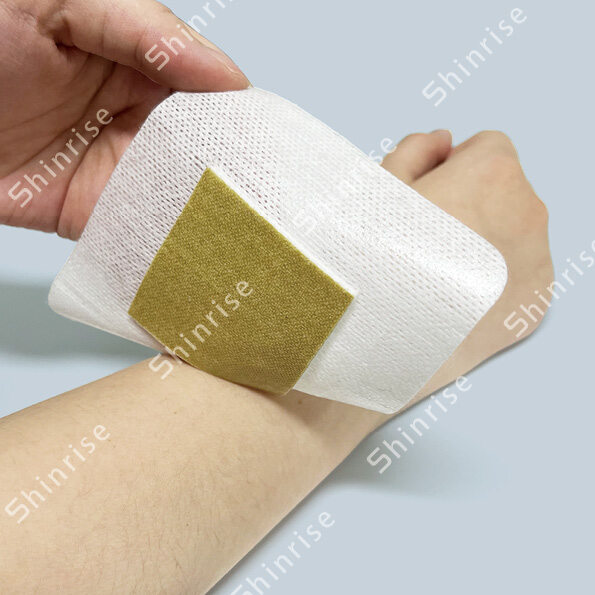Email cannot be empty
Password cannot be empty
Email format error
Email cannot be empty
Email already exists
6-20 characters(letters plus numbers only)
The password is inconsistent
Email format error
Email cannot be empty
Email does not exist
6-20 characters(letters plus numbers only)
The password is inconsistent


The Benefits and Applications of Colloidal Silver Wound Dressing
Wound care is an essential aspect of healthcare, requiring products that promote healing while preventing infection. Among the various options available, colloidal silver wound dressing stands out for its unique properties and effectiveness. This blog will delve into the benefits, applications, and science behind colloidal silver wound dressings, as well as compare it to other wound care products.
What is Colloidal Silver Wound Dressing?
Colloidal silver wound dressing is a type of wound care product that incorporates colloidal silver, a suspension of silver particles in a liquid, into the dressing material. Silver has been known for its antimicrobial properties for centuries and is widely used in medical settings to prevent and treat infections.
How Colloidal Silver Works
Silver ions released from the dressing penetrate bacterial cell walls, disrupting cellular function and preventing replication. This mechanism helps to reduce bacterial load in wounds, promoting a cleaner and more conducive environment for healing.
Types of Colloidal Silver Wound Dressings
1. Hydrocolloid Dressings: These dressings combine colloidal silver with a gel-forming agent, providing a moist environment that promotes wound healing while preventing infection.
2. Silver-impregnated Dressings: These are standard dressings that have been treated with colloidal silver, making them effective in reducing bacterial colonization.
3. Semipermeable Waterproof Plastic Wound Dressing with Silver: This type offers both protection and antimicrobial action, ideal for wounds at risk of exposure to water or other contaminants.
Benefits of Colloidal Silver Wound Dressing
Antimicrobial Properties
The primary benefit is their strong antimicrobial action. Silver is effective against a wide range of microorganisms, including bacteria, viruses, and fungi. This broad-spectrum activity helps prevent infections in wounds, especially those at high risk of contamination.
Enhanced Healing
By keeping bacterial load low, colloidal silver dressings create an optimal environment for wound healing. The reduced risk of infection means that the body's natural healing processes can proceed without interruption, often resulting in faster recovery times.
Versatility
The wound dressings are suitable for various types of wounds, including burns, surgical incisions, ulcers, and chronic wounds. Their versatility makes them a valuable addition to any wound care regimen.
Moisture Balance
Maintaining an appropriate moisture balance is crucial for wound healing. Colloidal silver dressings help manage exudate, keeping the wound bed moist but not overly wet. This balance is essential for cellular activity and tissue repair.
Applications of Colloidal Silver Wound Dressing
Acute Wounds
For acute wounds such as cuts, abrasions, and surgical incisions, the wound dressings provide immediate protection against infection and promote faster healing. Their antimicrobial action ensures that these wounds remain clean and free from harmful bacteria.
Chronic Wounds
Chronic wounds, such as diabetic ulcers and pressure sores, can be challenging to manage due to their persistent nature and high risk of infection. The wound dressings are particularly beneficial in these cases, as they help reduce bacterial colonization and support the body's healing processes.
Burn Care
Burns are highly susceptible to infection, making the wound dressings an excellent choice for burn care. The antimicrobial properties of silver help prevent infection while the dressing provides a protective barrier, reducing the risk of further injury.
Comparing Colloidal Silver Wound Dressings with Other Wound Care Products
Standard Dressings
Standard dressings, such as gauze and non-impregnated bandages, offer basic wound protection but lack antimicrobial properties. Colloidal silver wound dressings, on the other hand, provide an added layer of defense against infection, making them more effective in preventing complications.
Large Waterproof Wound Dressing
While large waterproof wound dressings offer excellent protection against external contaminants and water, they may not have antimicrobial properties. Colloidal silver wound dressings combine waterproof protection with antimicrobial action, offering a more comprehensive solution for wound care.
Advanced Wound Dressings
Advanced wound dressings, such as hydrocolloids and foam dressings, provide moisture management and protection. When combined with colloidal silver, these dressings become even more effective, offering both enhanced healing and infection control.
The Science Behind Colloidal Silver
Historical Use of Silver in Medicine
Silver has been used for medicinal purposes for centuries. Ancient civilizations recognized its antimicrobial properties and used silver containers to preserve liquids and silver leaf to treat wounds. Modern medicine has harnessed these properties in various applications, including wound care.
Mechanism of Action
The antimicrobial action of silver is primarily due to its ability to release silver ions. These ions interact with bacterial cell walls, proteins, and DNA, disrupting cellular processes and inhibiting growth. This mechanism makes silver highly effective against a broad spectrum of microorganisms.
Safety and Efficacy
Numerous studies have demonstrated the safety and efficacy of colloidal silver in wound care. When used appropriately, colloidal silver dressings are safe and do not pose significant risks of toxicity or resistance. However, it is essential to use these dressings as directed and under the guidance of healthcare professionals.
Best Practices for Using Colloidal Silver Wound Dressings
Selecting the Right Dressing
Choosing the appropriate colloidal silver wound dressing depends on the type and condition of the wound. For example, hydrocolloid dressings are suitable for wounds with moderate exudate, while silver-impregnated gauze may be better for dry wounds.
Application and Replacement
Proper application is crucial for the effectiveness of colloidal silver wound dressings. Ensure the wound is clean before applying the dressing. Follow the manufacturer's instructions for replacement frequency, typically every 24 to 48 hours or as needed based on the wound's condition.
Monitoring and Adjustment
Regular monitoring of the wound is essential to assess healing progress and adjust the dressing type or frequency if necessary. If there are signs of infection or if the wound is not healing as expected, consult a healthcare professional for further evaluation and treatment.
Conclusion
Colloidal silver wound dressings offer a powerful combination of antimicrobial action and wound protection, making them a valuable tool in modern wound care. Their versatility, enhanced healing properties, and ability to maintain moisture balance make them suitable for a wide range of wounds, from acute injuries to chronic conditions. By understanding the benefits and applications of colloidal silver wound dressings, healthcare providers and patients can make informed decisions to promote optimal wound healing and prevent infections.

